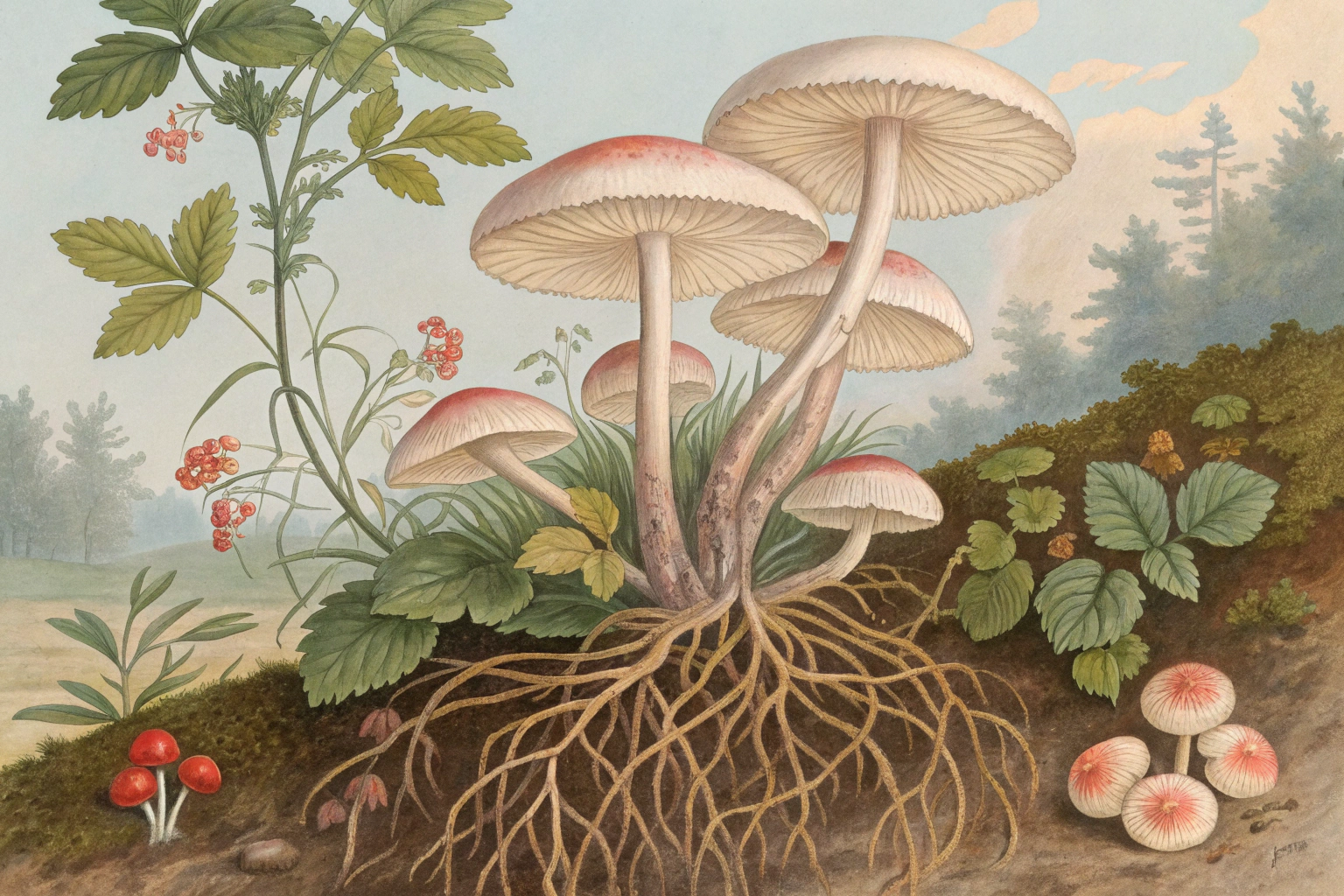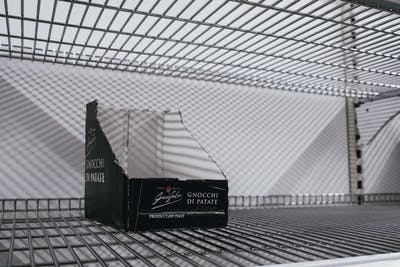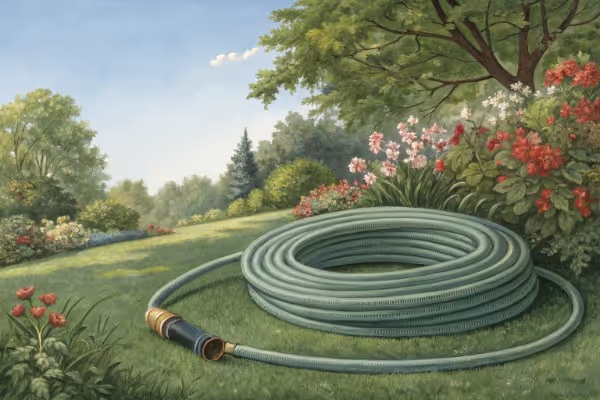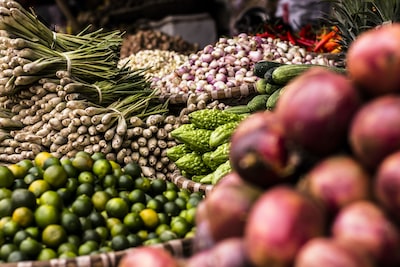The Science of Mycorrhizal Fungi and How They Boost Plant Health

Mycorrhizal fungi
Add mycorrhizal fungi at planting to boost nutrient uptake and drought tolerance. Mulch and skip tilling to protect mycorrhizal fungi networks that swap plant sugars for phosphorus and trace minerals. Cut high-phosphorus fertilizers; mycorrhizal fungi colonization drops when phosphorus is abundant. Here’s the science behind this underground pact, and how to make it work in your beds, pots, and orchard.
Cheatsheet: Mycorrhizal Fungi for Stronger Plants
🌱 Types & Effect
- Arbuscular (AMF): Works with veggies, fruits, ornamentals
- Ectomycorrhizal: Supports trees, woody plants
- Up to 90% of land plants partner with mycorrhizae
- Networks increase nutrient absorption by up to 80%
⚡ Benefits
- Faster growth and stronger roots
- More drought resistance
- Improved P, N, K uptake
- Higher yields & better-tasting produce
- Boosts immunity against soil pathogens
- Reduces need for chemical fertilizer by up to 30%
- Improves soil quality and carbon storage
🛠️ Tools and products you'll need
- Commercial mycorrhizal inoculant (granules or powder)
- Clean water
- Shovel or trowel
- Gloves
🚀 5-Step Application Guide
- Choose the right fungi: AMF for veggies/flowers, ecto for trees
- Sprinkle inoculant directly on root zone or mix with planting hole soil
- Use 1 tsp (5g) per plant or follow label rates
- Water thoroughly (50-70°F/10-21°C, keep soil moist)
- Avoid synthetic fungicides; minimize phosphorus fertilizer
🥗 Self-Sufficiency & Nutrition Impact
- Higher produce nutrient content (more vitamin C, polyphenols)
- Less need for synthetic inputs, sustainable gardens
- Healthier soil builds long-term food security
The science of mycorrhizal fungi, straight from the soil
I treat mycorrhizal fungi like an underground irrigation and nutrition crew, paid in sugars and paid well. They colonize roots, trade minerals and water for carbohydrates, and make beds and borders act older and wiser than they are.
Two big camps run the show. Arbuscular mycorrhizal fungi live inside the roots of most herbs, veggies and grasses, while ectomycorrhizae wrap around the roots of many trees like pines, oaks and birches.
How the partnership actually works
AMF send hairlike threads called hyphae into soil pores that roots cannot enter, scavenging phosphorus, zinc and water with clinical efficiency. In return, plants release signal molecules and sugars from the rhizosphere, green-lighting more fungal growth and exchange.
Inside the root, AMF build tiny branching structures called arbuscules where the trade happens. Around the root, they leave behind sticky proteins that help soil crumbs cling together, so beds stay open, springy and better aerated after rain.
Approximately 80 to 90 percent of plant species partner with mycorrhizal fungi. Source: USDA NRCS and Royal Botanic Gardens, Kew
What you can actually see in the garden
- Faster establishment after transplanting and fewer wilted afternoons during heat spikes.
- Improved phosphorus use where soil tests read low, which means you can dial back high P fertilizers.
- Thicker root systems with better crumb structure around them, so watering lasts longer between cycles.
- Some suppression of root pathogens by crowding and competition at the root surface.
Where mycorrhizal fungi shine and where they sit out
They shine in new beds, potting mixes, compacted urban soils and any place with low to moderate phosphorus. In long-tended beds rich in life and mulches, the native network often does the job already.
Some crops do not play ball. Brassicas like cabbage and kale refuse AMF, and chenopods like beet, chard and spinach barely respond.
Using mycorrhizal fungi the right way
Timing and application that actually works
- At seeding: dust seed or mix inoculant into the seed furrow so granules touch new roots.
- At transplant: slurry the product with water and dip bare roots, or sprinkle granular product into the hole right against the root ball.
- Established plants: inject or water in a soluble product at the dripline, then water lightly to move it into the root zone.
- Lawns and meadows: spread granular at 3 to 6 pounds per 1000 square feet, then irrigate well.
Keep the root contact rule sacred. Spores and root fragments need to touch live roots to colonize, so do not bury product off to the side and hope for the best.
Store products cool and dry around 40 to 77 F, 4 to 25 C. Avoid baking a bag in a shed or freezing it rock hard.
Shopping smart for mycorrhizal fungi
- Species fit: AMF for vegetables, grasses and most ornamentals, ectomycorrhizae for many conifers and hardwoods, ericoid types for blueberries and heathers, orchid types for orchids.
- Label transparency: look for named species such as Rhizophagus irregularis or Funneliformis mosseae and a clear propagule or spore count per gram.
- Carrier matters: fine granules stick to roots in the hole, soluble powders suit drenches and hydro, biochar carriers help in sandy soils.
- Viability and date: a recent manufacture date and a realistic shelf life beat flashy claims.
- Cost per planting, not per bag: calculate dollars per transplant or per 100 square feet to compare fairly.
- Additives: humic acids and kelp can help early colonization, while heavy starter phosphorus can delay it.
Top picks by use case
- Vegetable beds and raised beds: AMF blends heavy in R. irregularis with at least 1000 propagules per gram, granular for hole placement.
- New orchards and vineyards: combined AMF plus ecto formulas if you mix hosts, or single-type formulas matched to the tree list.
- Blueberries and heathers: ericoid mycorrhiza products designed for low pH, peat-based mixes.
- Pines, oaks and birch: ectomycorrhizal inoculant with Pisolithus and Laccaria species as granules under the root zone.
- Lawns and sports turf: AMF granules that pass through spreaders cleanly and survive irrigation cycles.
- Houseplants and tropicals: AMF powders for root dips at repotting to offset sterile mixes.
Benefits show up strongest in low phosphorus soils and at planting. University extension guidance across several states echoes this pattern
Mistakes that sabotage the symbiosis
- Overdoing phosphorus at planting. High soluble P slows colonization, so use modest starter blends and let the fungi do the early heavy lifting.
- Soil drenches with broad-spectrum systemic fungicides near transplant time. Wait a few weeks, use targeted products, or choose biologicals.
- Deep tillage every season. Save the big steel for resets, then switch to shallow cultivation, mulches and cover roots to keep networks intact.
- Letting mixes swing from bone dry to swampy. Keep an even moisture profile the first month to help hyphae bridge soil crumbs.
- Expecting compost tea to supply mycorrhizae. These fungi need living roots to multiply and do not thrive in a bubbled bucket.
Field notes from beds, borders and buckets
In my peppers and tomatoes I see thicker roots and calmer afternoons during hot spells when I dust seedlings at pot-up and again in the hole. The first time I tried it in a sandy plot, irrigation frequency dropped from daily to every second day once the network took hold.
Corn and prairie grasses jump with AMF in new ground, while cabbage and radish ignore it completely. Blueberries only responded after I switched from AMF to an ericoid inoculant and kept soil near pH 4.8 to 5.2.
Container basil under greenhouse heat ran cleaner with fewer root rots after a root dip and lighter phosphorus, and I did not change varieties or media. The smell of the potting mix shifted toward that sweet forest note as aggregates formed and percolation improved.
Build native networks for the long haul
- Keep living roots in the ground with off-season cover crops, even a quick buckwheat or oats mix.
- Mulch with leaves, straw or chipped wood to feed fungal pathways and protect hyphae from UV and heat.
- Leave some fungal food near trees. Wood chips help ecto partners around oaks and conifers.
- Match fertilizer to soil tests and avoid chronic high P. Plants partnered with fungi pull more from low to moderate reserves than you think.
- Water deeply and less often to train roots and hyphae to explore volume, then let the surface dry between rounds.
FAQ that gardeners actually ask
Do I need mycorrhizal fungi in rich garden soil
Maybe not. If your beds carry steady mulches, diverse plantings and you rarely till, the natives usually thrive on their own.
Can I add it after planting
Yes. Use a soluble drench at the dripline and water it in so spores move into the root zone.
Does biochar help
Sometimes. It can act as a carrier and provide habitat in sandy soils, as long as it is precharged with compost or nutrient solution.
Can I use it with synthetic fertilizer
Yes. Keep phosphorus modest and avoid harsh salt spikes the first month while colonization starts.
What about pH and temperature
AMF tolerate a wide pH but run best near 5.5 to 7.5. Store inoculants cool at 40 to 77 F, 4 to 25 C, and avoid hot sheds.
Will it fix a disease problem
It helps roots occupy space and compete, but it is not a silver bullet. Pair it with sanitation, drainage and cultivar choice.
Credible sources I trust for deeper reading
- USDA NRCS Soil Biology Primer on Mycorrhizae
- Royal Horticultural Society guidance on mycorrhizal fungi and plant groups
- Penn State Extension and University of California Cooperative Extension publications on AMF benefits and use
- Royal Botanic Gardens, Kew resources on fungi and plant partnerships
- Peer reviewed syntheses on mycorrhizal inoculation and context dependence in Ecology Letters and related journals
Plants and fungi have traded resources for over 400 million years. Give them decent conditions and they handle the fine print

Want smarter plant choices? 🪴
Frequently Asked Questions about Mycorrhizal Fungi for Plant Health
How do mycorrhizal fungi improve nutrient uptake in plants?
Mycorrhizal fungi form symbiotic relationships with plant roots, producing a dense network of filaments called hyphae. These hyphae extend far beyond root zones, absorbing phosphorus, nitrogen, zinc, and other essential minerals from the soil. This process supplies plants with more resources than root hairs could collect on their own, leading to improved nutrition and growth.
Can mycorrhizal fungi help plants tolerate drought or heat?
Yes. Mycorrhizal fungi support plant survival in dry or hot conditions by enhancing water absorption and retention near root systems. Their extended network increases the surface area for water uptake, reducing plant stress during heat waves or when temperatures hit 95°F (35°C) and above.
Will applying mycorrhizal fungi protect plants from disease?
Mycorrhizal associations strengthen plant immunity. The fungi foster a natural barrier near roots, which prevents harmful soil pathogens from invading. Some strains also trigger biochemical changes within plants, which further heighten disease resistance.
Do all plants benefit from mycorrhizal fungi?
Most flowering plants, shrubs, and trees develop positive connections with mycorrhizal fungi. However, some families such as Brassicaceae (cabbage, broccoli) and Chenopodiaceae (spinach, beets) rarely form these symbiotic bonds. Always check which species show compatibility before adding fungus products.
What gardening practices help cultivate healthy mycorrhizal fungi?
Minimize or avoid high-phosphorus fertilizers, excessive digging, or heavy pesticide use, since these can disrupt fungal networks. Instead, maintain consistent mulch layers, organic compost, and undisturbed soil structure, which encourage fungi to thrive and connect with plant roots.
Should I inoculate my soil with commercial mycorrhizal fungi?
If your soil has experienced disruption from tillage, construction, or synthetic chemicals, inoculation can establish or restore beneficial fungal populations. Look for reputable brands tailored for your plants and soil type. Use fresh, high-quality inoculants for the best results.
How do soil temperature and pH impact mycorrhizal fungi?
Optimal activity occurs between 60°F to 80°F (16°C to 27°C); activity slows in colder or extremely hot soils. A pH range of 5.5 to 7.0 suits most mycorrhizal fungi. Acidic or highly alkaline soils reduce their growth and effectiveness, so regular soil testing keeps conditions favorable.
Mycorrhizal fungi are the quiet partner at the root zone. They trade plant sugars for minerals and moisture in tight symbiosis, weaving hyphae through soil to widen the reach of every root. Expect steadier nutrient uptake, better water use, and a sturdier response to stress and disease. Nurture the network and the whole bed steadies.
Keep soil alive: plant diverse hosts, tuck in organic mulch, water deeply, disturb sparingly, and go easy on high-phosphate fertilizers. Aim for drainage that avoids soggy pots and beds; if you battle root rot, tighten watering and airflow first. Seedlings need clean starts; while the fungal partnership builds, a light touch with cinnamon powder on seedlings can curb damping-off. Treat mycorrhizal fungi like any good crew: feed them, give them space, and they'll feed your garden.
Mycorrhizal Fungi: The Prepper’s Resilience Toolkit
Mycorrhizal fungi forge resilient lifelines underground, making any preparedness garden more efficient, drought-resistant, and nutrient-rich with zero synthetic inputs. NASA studies suggest mycorrhizae boost plant drought resistance by up to 40%. This symbiosis can transform poor soils into productive growing zones, valuable for anyone seeking self-sufficiency.
Low-Tech Propagation
- Trap plants: Grow grasses or leeks in your worst soil. After 4-6 months, roots and adjoining soil bristle with beneficial spores.
- In-situ inoculation: Gently uproot, break root clumps, and replant fragments beneath target crops. Favor moisture during establishment; avoid phosphorus-rich synthetic fertilizer.
- Wild collection: Forest leaf litter and humus yield native fungi. Mix 10-20% into garden beds; avoid roots from conifers which may host non-beneficial types.
Long-Term Storage and Shelf Life
- Dry, cool storage (35-50°F/2-10°C) extends spore viability up to 2 years. Avoid direct sun and humid areas.
- Mix dry mycorrhizal material with coarse sand or vermiculite to prevent spoilage and clumping.
Essential Tools for the Self-Reliant
- Spade or hori-hori knife for gentle root division.
- 5-gallon/20-liter buckets for carrying inoculated soil.
- Watering can or rain barrel to avoid chlorinated city water, which slows fungal establishment.
Nutrition and Protection
- Mycorrhizal fungi increase B vitamin and micronutrient levels, such as zinc and copper, in tomatoes, greens, and alliums. This offers additional dietary security in lean times.
- Crop yields typically rise 10-30% with inoculation, according to FAO research.
- Plants grown with mycorrhizae show up to 60% less root disease.
No-Buy Backup
- Fungal networks recover after wildfire or flood in as little as 8 weeks if root fragments survive. Use “living soil” from weed-free areas as biological insurance if disaster hits.
- Compost tea: Steep root-rich soil in rainwater 24 hours. Strain and use as liquid inoculant on new beds or seedlings.
Mycorrhizal fungi lock in long-run fertility, boost emergency yields, and fortify plants against stress—an engine for food independence and low-input resilience.
Find out which plants will thrive in your garden!
Answer a few fun questions and get custom plant recommendations perfect for your space. Let’s grow something amazing together!

start your season





